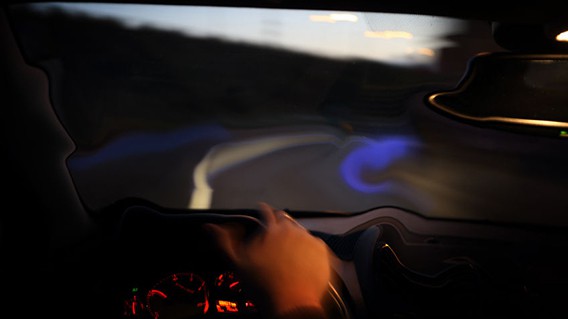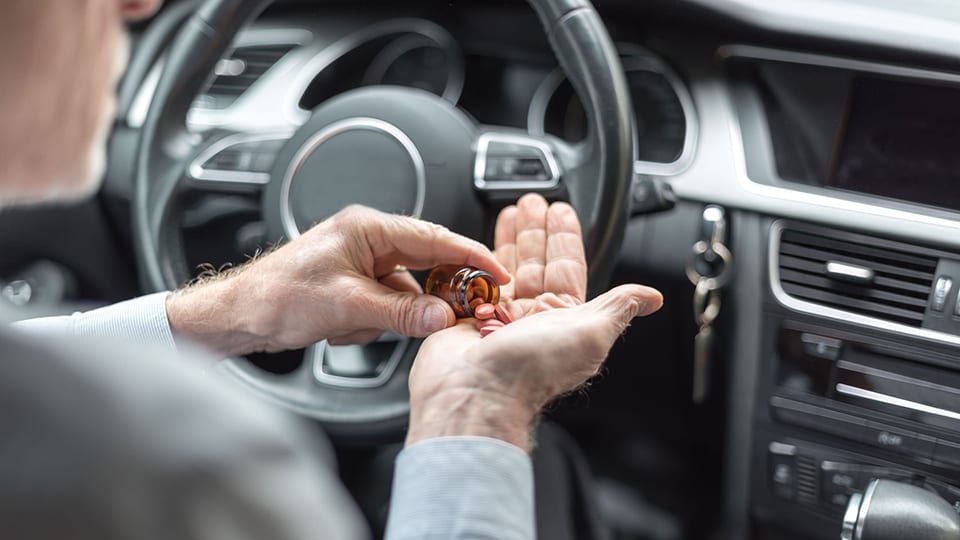In California, it is illegal to drive under the influence of any drug, regardless of whether the drug is legal or illegal. Drugs, for these purposes, include any substance other than alcohol that impairs the driver.
The crime of driving under the influence is often abbreviated “DUI.” A drug-related DUI can include driving under the influence of recreational drugs, such as: marijuana, cocaine, LSD, and meth. It can also include legal substances—like over-the-counter or prescribed medicines—if taken in an amount high enough to impair the person’s ability to drive.
This article explores drug-related driving offenses in California, and what it means for someone to be charged with one.s.
{index}
Drunk Driving vs. Driving on Drugs
California Vehicle Code section 23152 governs both alcohol- and drug-related DUIs. While the consequences for driving under the influence of drugs and alcohol are similar, some things are different for drug-related DUIs.
| Alcohol-Related DUIs | Drug-Related DUIs |
|---|---|
| A specific blood-alcohol content (BAC) can indicate influence. | There is no specific content level for drugs to be considered influencing. |
| Alcohol is generally legal to be consumed by adults over the age of 21. | All substances that influence the mind or body, other than alcohol, are considered drugs. They may be legal or illegal and still result in a conviction for driving under the influence of drugs. |
| Alcohol can be detected by breathalyzer, administered by a police officer in the field. | At the time of the writing of this article, there is no breathalyzer used to detect the influence of drugs. |
The Elements of a Drug-Related DUI

To be convicted of a crime in California, several facts must be proven. These are called “elements” of the crime. In cases involving driving under the influence of drugs (“DUI”), the elements are provided by California Vehicle Code sections 23152. Those are as follows:
- Driving. You drove a motor vehicle, even if only a little. The vehicle can be a car, motorcycle, motorbike, bus, dirt bike, ATV, motorized scooter, etc. It does not include human-powered objects, like bicycles.
- Under the Influence of Drugs. When you drove the motor vehicle, you were under the influence of drugs. California law does not state which drugs, or how much of any drug is the minimum for being under the influence. But a driver is considered under the influence if they are unable to drive the vehicle with the caution of a sober person.
These elements are explored in more detail below.
Driving
Under California law, driving is the willful and intentional controlling of a car to make it move. A driver is “driving” when they cause the car’s wheels to turn and move the car, even if only an inch away.
Importantly, however, simply sitting behind the wheel does not constitute driving for the purposes of a DUI charge. But it can still be circumstantial evidence that the vehicle was recently driven under the influence of drugs.
Intoxication
The phrase under the influence of any drug means being impaired by any substance or combination of substances. A person is impaired, for these purposes, if their ability to think, react, move, or make decisions is negatively altered.
This language is intentionally broad, and can include a wide variety of substances and effects.
Example
A person drank 23 cups of kava root tea—a mood-lifting supplement—before driving. The kava tea impaired his ability to drive.
A court held that the law was meant to be broad enough to include anything other than alcohol that could impair the body or mind of a driver. Because the driver’s ability to operate a vehicle was impaired, he was guilty of driving under the influence of a drug.
Importantly, a driver does not have to obviously high to be under the influence, so long as the drug exerts some influence on the driver that impairs driving ability.
At the same time, it is possible for a driver to have a drug present in his or her body and experience no actual effects from it. If the driver is not actually affected by the drug, the person is not considered “under the influence.”
Mixing Alcohol and Drugs
Although some parts of Vehicle Code section 23152 specifically deal specifically with alcohol, combining drugs and alcohol of any amount is driving under the influence, so long as the driver is impaired.
Example
A driver takes an oxycodone (legally or illegally) and washes it down with a beer before driving. That driver may not have an unlawfully-high blood-alcohol content (BAC), but they would still be unlawfully driving under the influence if the combination of the two substances caused them to be impaired.
Penalties for a Conviction of Driving Under the Influence of Drugs

The penalties for drug-related DUI offense are the same as alcohol-related DUI offenses.
The penalties, however, are not the same for drug-related DUI as they are for other drug-related misdemeanors. If a driver is convicted of a drug-related DUI, he or she is ineligible for Proposition 36 probation for non-violent drug offenses unless a judge dismisses the driving offense.
First Offense
The sentence in DUI cases can vary significantly depending on whether the defendant has previous offenses. If the defendant has no previous offenses, a violation of Vehicle Code section 23152 will be charged as a misdemeanor. The available punishments are as follows:
| Code Section | Vehicle Code, §§ 23152, 23536 |
| Violation Type | Misdemeanor |
| Custody Time | Imprisonment in county jail for at least 96 hours, but no more than six months. |
| Additional Consequences |
|
Second Offense
If, in the last 10 years, the defendant has one of the following convictions, they will face a higher range punishments:
- Reckless driving,
- Driving under the influence of drugs or alcohol, or
- Driving under the influence of drugs or alcohol causing injury.
If the defendant has only been convicted of one previous offense in the last ten years (meaning, the current offense is their second), a charge for driving under the influence of drugs will still be treated as a misdemeanor. The punishment in that case is as follows:
| Code Section | Vehicle Code, §§ 23152, 23540 |
| Violation Type | Misdemeanor |
| Custody Time | Imprisonment in county jail for at least 90 days, but no more than one year. |
| Additional Consequences |
|
Third Offense
If, in the last 10 years, the defendant has two of the following convictions, they will face a higher range punishments:
- Reckless driving,
- Driving under the influence of drugs or alcohol, or
- Driving under the influence of drugs or alcohol causing injury.
If the defendant has only been convicted of two previous offense in the last ten years (meaning, the current offense is their third such offense), a charge for driving under the influence of drugs will still be treated as a misdemeanor. The punishment in that case is as follows:
| Code Section | Vehicle Code, §§ 23152, 23546 |
| Violation Type | Misdemeanor |
| Custody Time | Imprisonment in county jail for at least 120 days, but no more than one year. |
| Additional Consequences |
|
Fourth or Later Offense
If, in the last 10 years, the defendant has three or more of the following convictions, they will face a higher range punishments:
- Reckless driving,
- Driving under the influence of drugs or alcohol, or
- Driving under the influence of drugs or alcohol causing injury.
In such a case, a charge for driving under the influence of drugs can be treated as a misdemeanor or a felony. The range of punishments in that case is as follows
| Code Section | Vehicle Code, §§ 23152, 23550 |
| Violation Type | Can be charged as a misdemeanor or a felony (depending on the prosecutor’s discretion). |
| Custody Time | If charged as a misdemeanor, between 120 days and one year in county jail. If charged as a felony, up to three years in state prison. |
| Additional Consequences |
|
Other Consequences of a Drug-Related DUI
In addition to the sentencing consequences discussed above, a conviction for driving under the influence of drugs can have some significant consequences on a person’s life. Those include:
- The driver may face additional narcotics charges, such as a charge for the illegal use of a controlled substance, possession of a controlled substance, or distribution of or intention to distribute a controlled substance.
- Moving violations may result in loss of car insurance. Alternatively, insurance companies may refuse to insure the driver, except at very high premiums.
- Convictions for drug-related driving offenses are a matter of public record, even they were charged as misdemeanors. Potential employers can find them in a background check.
- A conviction can make it substantially difficult, if not nearly impossible, to get a job working with or around controlled substances.
- A conviction for driving under the influence of drugs can make it more difficult to enter the teaching, medical, or legal professions.
- A conviction for driving under the influence can make finding a job as a driver very difficult.
- A drug-related DUI conviction can negatively affect a divorce or child custody proceeding.
Possible Defenses to a Charge of Driving Under the Influence of Drugs

Driving under the influence of drugs is a strict liability offense. A strict liability offense means that the driver does not need to have criminal intent or prior knowledge that he or she will drive around under the influence before committing the offense.
It does not matter if the driver thought he or she was sober despite knowingly taking the drug, or thought that the drug couldn’t impair his or her mind or body. A driver could still be convicted for a drug-related DUI so long as the defendant had drugs in their system and they were impaired.
There are, however, several defenses to a drug-related DUI charge. Those include:
Substance Was Not a Drug
If the substance ingested by the driver was not legally a “drug,” the defendant cannot be convicted of driving under the influence of drugs.
This defense can be tricky, given that California law defines drugs very broadly. However, if the substance purported to be a drug doesn’t actually impair the mind or body, then it is not a drug. If it isn’t a drug, then it can’t be a factor in a drug-related DUI.
Driver Was Sober
If the driver was not impaired by the drugs, they are not guilty of driving under the influence of drugs. This is true even though an actual drug was present in the driver’s system, so long as the amount ingested was insufficiently powerful to put the driver under the influence (or was taken long enough before the driving occurred that its impairing effects had worn off).
This defense may require challenging the results of sobriety and chemical drug tests. It may also require consulting an expert in pharmacology or other qualified expert, and having one testify on your behalf, in accordance with the rules of evidence.
The Drug Did Not Cause Impairment
In a situation where there are drugs present in the driver’s system, the actual impairment can sometimes be caused by somethign else. If the drugs did not actually cause impairment, the driver might have a valid defense to the crime of driving under the influence of drugs, even though the drug was present.
Example
A driver may test positive for ephedrine. The driver did in fact take asthma medication. However, the impairment that caused the driver to drive poorly was the asthma attack the driver was trying to medicate.
No Driving Occurred
It’s not unusual for those involved in a car accident to get out of the vehicle, even in the case of DUI. If there is more than one person per car at the scene, it can be difficult to determine who was driving.
A person is not guilty of driving under the influence of drugs if they simply sat in the driver’s seat of the car without moving the vehicle.
It is also not a DUI to drive somewhere, stop driving, and then use drugs without driving again. Even if the accused was under the influence of drugs at the time of arrest, if he or she wasn’t actually driving at time he or she was influenced by drugs, there is no DUI.
Involuntary Intoxication
Even though driving under the influence of drugs is a strict liability offense, involuntary intoxication is a potential defense. If the driver did not know they had ingested a drug before driving and fell unconscious, they might not be guilty of the crime.
Example
A victim of a dosing or spiked drink may not know that he or she have become intoxicated, and may not be able to stop driving before the drug impairs his or her ability to stop.
Strategies for Defending DUI Cases
The prosecution has the burden of proving all the elements of crime in order to get a conviction, while the defense only has to disprove at least one element. To prosecute a drug-related DUI case and secure a conviction, the prosecution must prove, beyond a reasonable doubt, that the defendant was: (1) driving a motor vehicle, (2) while they were under the influence of a drug.
If the defense can successfully disprove one of these elements, then the driver cannot be convicted for driving under the influence of a drug. The best defense strategy is to focus on the element for which the prosecution has the least proof. Here are some strategies to do that:
Challenge the Sobriety Test
Field tests, blood tests, and urine tests are not 100% accurate or foolproof. False positives, contaminated tests, and lab mix-ups could result in a positive result and an arrest even if the driver is not under the influence.
Challenge Government Misconduct
The police and the prosecution have procedures they must obey to ensure that the public is protected and that justice is served—for everyone—including those accused of offenses. Improperly acquired evidence may be inadmissible in court.
Plea Bargaining
If the prosecution does not have strong evidence that the driver was under the influence of drugs, the driver can sometimes enter a guilty or no contest plea to a lesser, but different charge. This can help the driver stay out of jail, negotiate a lighter sentence, and avoid becoming a habitual offender.
Final Thoughts
If you are currently facing a charge of driving under the influence of drugs, the facts in your case matter. They can mean the difference between acquittal and conviction. You may be able to get a lighter sentence and plea to a lesser charge.
An experienced criminal defense attorney can argue on your behalf to help you get a favorable deal and shield you from unfair conviction or sentencing. To get legal advice from a sympathetic and honest criminal defense attorney, call Long Beach Criminal Lawyer at 562-304-5121.
References
-
Vehicle Code, § 23152, subd. (f) [“It is unlawful for a person who is under the influence of any drug to drive a vehicle.”].
-
Vehicle Code, § 312 [“The term ‘drug’ means any substance or combination of substances, other than alcohol, which could so affect the nervous system, brain, or muscles of a person as to impair, to an appreciable degree, his ability to drive a vehicle in the manner that an ordinarily prudent and cautious man, in full possession of his faculties, using reasonable care, would drive a similar vehicle under like conditions.”].
-
Vehicle Code, §§ 312, 23152, subd. (a) [“This section specifically states that being under the influence of an ‘alcoholic beverage’ while driving is unlawful.”].
-
Padilla v. Meese (1986) 184 Cal.App.3d 1022, 1029 [“It is true that the driver . . . only moved the car slightly. But the movement need not be extensive; even a matter of a few inches will suffice to constitute driving. In our view, if the driver does not move the vehicle in the officer’s presence, the offense is not committed in his presence.”].
-
Veh. Code, § 670 [“A ‘vehicle’ is a device by which any person or property may be propelled, moved, or drawn upon a highway, excepting a device moved exclusively by human power or used exclusively upon stationary rails or tracks.”].
-
Clingenpeel v. Municipal Court (1980) 108 Cal.App.3d 394, 399.
-
Vehicle Code, § 23152.
-
CALCRIM No. 2110; Vehicle Code, § 23152, subds. (a), (f); see also Health & Saf. Code, § 11550; People v. Schoonover (1970) 5 Cal.App.3d 101, 105.
-
Henslee v. Dep’t of Motor Vehicles (1985) 168 Cal.App.3d 445, 451–452; Padilla v. Meese (1986) 184 Cal.App.3d 1022, 1029.
-
In re Queen T. (1993) 14 Cal.App.4th 1143, 1145 [“Minor’s act of steering the car, although she was not operating the accelerator or brakes, renders her a ‘driver’ within the meaning of sections 305 and 23153.”].
-
Music v. Dep’t of Motor Vehicles (1990) 221 Cal.App.3d 841, 850 [“[I]f the driver does not move the vehicle in the officer’s presence at least a few inches, the offense of driving under the influence has not occurred in the officer’s presence. Any ensuing warrantless arrest is invalid”].
-
Vehicle Code, § 312.
-
People v. Olive (2001) 92 Cal.App.4th Supp. 21, 26.
-
See People v. Torres (2009) 173 Cal.App.4th 977, 983 [“To be guilty of driving while under the influence of drugs in violation of Vehicle Code section 23152, subdivision (a), ‘”the . . . drug(s) must have so far affected the nervous system, the brain, or muscles [of the individual] as to impair to an appreciable degree the ability to operate a vehicle in a manner like that of an ordinarily prudent and cautious person in full possession of his faculties. It is not enough that the drug could impair an individual’s driving ability or that the person is under the influence to some detectable degree. Rather, the drug must actually impair the individual’s driving ability.”], quoting People v. Canty (2004) 32 Cal.4th 1266, 1278; People v. Enriquez (1996) 42 Cal.App.4th 661, 665–666.
-
Vehicle Code, § 23152, subd. (g) [“It is unlawful for a person who is under the combined influence of any alcoholic beverage and drug to drive a vehicle.”].
-
See Vehicle Code, § 23152.
-
People v. Canty (2004) 32 Cal.4th 1266, 1278–1279 [“Driving while under the influence of drugs involves a greater impairment of an individual’s faculties, and in that respect is not ‘similar’ to being merely under the influence of drugs.”].
-
Vehicle Code, § 23536.
-
Veh. Code, §§ 23103, 23103.5.
-
Veh. Code, § 23152.
-
Veh. Code, § 23153.
-
Veh. Code, § 23540.
-
Veh. Code, §§ 23103, 23103.5.
-
Veh. Code, § 23152.
-
Veh. Code, § 23153.
-
Veh. Code, § 23546.
-
Veh. Code, §§ 23103, 23103.5.
-
Veh. Code, § 23152.
-
Veh. Code, § 23153.
-
Veh. Code, § 23550.
-
But it could be circumstantial evidence that the driver had committed DUI if there is proof that the driver was operating a vehicle for a significant portion of time before the drug test.
-
See Evid. Code, §§ 801, §802 [providing specific rules governing expert witnesses].
-
But it is a DUI to drive back
-
People v. Cruz (1978) 83 Cal.App.3d 308, 313 [“Unconsciousness due to involuntary intoxication is recognized as a complete defense to a criminal charge.”].
-
Patterson v. New York (1977) 432 U.S. 197, 210.
-
Veh. Code, § 23152.
-
Although there might be an available conviction for a different crime.





